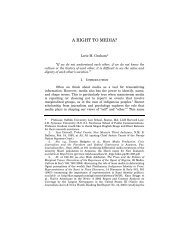The Right to Dignity Rex D. Glensy - Columbia Law School
The Right to Dignity Rex D. Glensy - Columbia Law School
The Right to Dignity Rex D. Glensy - Columbia Law School
You also want an ePaper? Increase the reach of your titles
YUMPU automatically turns print PDFs into web optimized ePapers that Google loves.
2011] <strong>The</strong> <strong>Right</strong> <strong>to</strong> <strong>Dignity</strong> 115<br />
States, but in a changing society, where the years of dependency at<br />
the end of one’s life are increasing, it is something that ought <strong>to</strong> be<br />
considered. After all, it certainly is in the state’s interest not <strong>to</strong> have<br />
a huge underclass of destitute or quasidestitute children, mothers,<br />
elderly people, or sick people. 230<br />
However, the positive reading of the right <strong>to</strong> dignity does not<br />
merely play out as a matter of public law. Private rights of action<br />
against other private parties are also a staple of a robust right <strong>to</strong><br />
dignity. In accordance with this principle, “every individual . . .<br />
should be recognized as having the capacity <strong>to</strong> assert claims <strong>to</strong><br />
protect [his] essential dignity.” 231 <strong>The</strong>se claims are not, strictly<br />
speaking, new <strong>to</strong> the American system. However, they would have <strong>to</strong><br />
be slightly re<strong>to</strong>oled so that specific and definite injuries <strong>to</strong> a person’s<br />
dignity would give rise <strong>to</strong> legally cognizable claims. <strong>The</strong> causes of<br />
action relating <strong>to</strong> a violation of one’s dignity are defamation,<br />
publication of private facts, intrusion in<strong>to</strong> seclusion, misappropriation<br />
of the right <strong>to</strong> publicity, and, quite possibly, copyright and trademark<br />
infringement. 232 Broadly speaking, what links all of these rights of<br />
action is the nature of the injury that they cause: reputation, image,<br />
privacy, and name, can all be tied <strong>to</strong> a theory of human dignity.<br />
<strong>The</strong> key difference in the affirmative mandate explored above,<br />
which is one facet of a positive version of the right <strong>to</strong> dignity, is that<br />
here the dignity norm places upon private parties the duty not <strong>to</strong><br />
violate such interest in others. In other words, the affirmative<br />
mandate is translated in<strong>to</strong> a specific code of conduct applicable <strong>to</strong> the<br />
private individual that then can be acted upon by another private<br />
230. Even people not generally prone <strong>to</strong> accepting that the state should<br />
provide a supporting role in these circumstances do concede that there is some<br />
element of state responsibility in this area. See, e.g. Mary Anne Case, How High<br />
the Apple Pie? A Few Troubling Questions about Where, Why, and How the Burden<br />
of Care for Children Should be Shifted, 76 Chi.Kent L. Rev. 1753, 1785 (2001)<br />
(acknowledging some collective responsibility for child care issues).<br />
231. See Schachter, supra note 14, at 851; see also Hendriks, supra note<br />
229, at 472 (“<strong>Dignity</strong> . . . is also sometimes interpreted as imposing duties on<br />
individuals <strong>to</strong>wards other members of the community, <strong>to</strong> ensure that everyone<br />
can lead a dignified life.”).<br />
232. For example, in the copyright context, the fair use doctrine is used <strong>to</strong><br />
determine when someone is entitled <strong>to</strong> use copyrighted material without seeking<br />
permission of the copyright owner. While the fair use doctrine essentially focuses<br />
on the economic harms suffered by the copyright owner, it is not difficult <strong>to</strong> see<br />
how dignitary interests can be affected by an improper use of a copyrighted work<br />
and thus, under a positive view of dignity rights, these ought <strong>to</strong> be taken account<br />
of in a fair use analysis.















